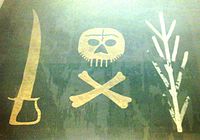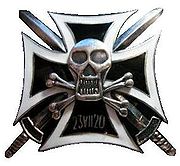Totenkopf (lit. "skull"[1]) is the German word for the skull and crossbones and death's head symbols. The "Totenkopf"-symbol is an old international symbol for death, danger or the dead, as well as piracy. It consists usually of the human skull with or without the mandible and often includes two crossed long-bones (femurs), most often depicted with the crossbones being behind some part of the skull. The grammatical translation of Totenkopf would be dead head, not death's head,[2] which would be Todeskopf, but no such word is in use; on the other hand the word used to refer to the skull anatomically or medically is Schädel. Totenkopf applies to symbolic depictions of the human skull. Skull and bones is "Totenkopf mit Knochen" in German.
German military[]
Prussia[]

Hussar from Husaren-Regiment Nr.5 (von Ruesch) in 1744 with the Totenkopf on the mirliton (ger. Flügelmütze).

August von Mackensen, German field marshal in hussar full dress prior to 1914, with the Totenkopf on his fur busby.
Use of the symbol as a military insignia began with the cavalry of the Prussian army under Frederick the Great. Frederick formed Husaren-Regiment Nr. 5 (von Ruesch), a Hussar regiment commanded by Colonel von Ruesch. These Hussars adopted a black uniform with a Totenkopf emblazoned on the front of their mirlitons and wore it on the field in the War of Austrian Succession and in the Seven Years' War.
In 1808, when the regiment was reformed into Leib-Husaren Regiments Nr.1 and Nr.2, the Totenkopf remained a part of the uniform. During the Napoleonic Wars, when Frederick William, Duke of Brunswick-Wolfenbüttel, was killed in battle, his troops changed the colour of their uniforms to black or apple green, with a Totenkopf on their shakos in mourning their dead leader (Other sources claim that the "Black Brunswickers" were so equipped while Friedrich Wilhelm of Brunswick lived, as a sign of revenge on the French.[3]
The skull continued to be used throughout the Prussian and Brunswick Armed forces until 1918, and some of the stormtroopers that led the last German offensives on the Western Front in 1918 used skull badges.[4]
Weimar Republic[]
The Totenkopf was used in Germany throughout the inter-war period, most prominently by the Freikorps. In 1933, it was in use by the regimental staff and the 1st, 5th, and 11th squadrons of the Reichswehr's 5th Cavalry Regiment as a continuation of a tradition from the Kaiserreich.
Third Reich[]

The second version of the SS-Totenkopf; used from 1934 to 1945

Junkers Ju 88 of Kampfgeschwader 54 (KG 54) in France, November 1940
In the early days of the NSDAP, Julius Schreck, the leader of the Stabswache (Adolf Hitler's bodyguard unit), resurrected the use of the Totenkopf as the unit's insignia. This unit grew into the Schutzstaffel (SS), which continued to use the Totenkopf as insignia throughout its history. According to a writing by Reichsführer-SS Heinrich Himmler the Totenkopf had the following meaning:
The Skull is the reminder that you shall always be willing to put your self at stake for the life of the whole community.[5]
The Totenkopf was also used as the unit insignia of the Panzer forces of the German Heer (Army), and also by the Panzer units of the Luftwaffe, including those of the elite Fallschirm-Panzerdivision Hermann Göring.[6]
Both the 3rd SS Panzer Division of the Waffen-SS, and the World War II era Luftwaffe's 54th Bomber Wing Kampfgeschwader 54 were given the unit name "Totenkopf", and used a strikingly similar-looking graphic skull-crossbones insignia as the SS units of the same name.
Non-German military[]

A French Hussard de la mort (1792)

Spanish Carlist flag (1838)

The "death's head" was the sign of Polish Death Hussar Divisions from 1920 (Polish–Soviet War)

United States Air Force 400th Missile Squadron uniform, from sometime between 1995 and 2005, with modified Totenkopf on shoulder sleeve insignia
- A skull and crossbones has often been a symbol of pirates, especially in the form of the Jolly Roger, but usually having the crossbones under the skull rather than behind it.
- The Italian elite storm-troopers of the Arditi used a skull with a dagger between its teeth as a symbol during World War 1. Various versions of skulls were also later used by the Italian Fascists.
- The British Army's Queen's Royal Lancers continue to use the skull and crossbones in their emblem, inherited from its use by the 17th Lancers, a unit raised in 1759 following General Wolfe's death in Quebec. The emblem contains an image of a death's head, and the words 'Or Glory', chosen in commemoration of Wolfe.[7]
- In 1792, a regiment of Hussards de la mort (Death Hussars) was formed to defend the young French Republic from the Austrian attempt to invade France.[8]
- South Korea's 3rd Infantry Division (백골부대) have a skull-and-crossbones in their emblem.[citation needed]
- The primarily Prussian 41st Regiment New York Volunteer Infantry, Mustered in: June 6, 1861-Mustered out: December 9, 1865 wore a skull insignia.[9]
- The lancers of the Portuguese Army Police 2nd Lancers Regiment use a skull-and-crossbones image in their emblem, similar to the one used by the Queen's Royal Lancers.
- The Kingdom of Sweden's Hussar Regiments wore a death's head emblem in the Prussian Style on the front of the mirleton.
- Ramón Cabrera's regiment adopted in 1838 a skull with crossbones flanked by an olive branch and a sword on a black flag during the Spanish Carlist Wars.
- The White Russian Kornilov regiment adopted a death's head emblem in 1917.
- The Estonian Kuperjanov's Partisan Battalion used the skull-and-crossbones as their insignia (since 1918); the Kuperjanov Infantry Battalion continues to use the skull and crossbones as their insignia today.
- Two Polish small cavalry units used death's head emblem during Polish–Ukrainian War and Polish–Soviet War - Dywizjon Jazdy Ochotniczej (also known as Huzarów Śmierci i.e. Death Hussars) and Poznański Ochotniczy Batalion Śmierci.
- During 1943-1945 the Italian Black Brigades and numerous other forces fighting for the Italian Social Republic, wore various versions of skulls on their uniforms, berets, and caps.
- Although not exactly a Totenkopf per se, the Chilean guerrilla leader Manuel Rodríguez used the symbol on his elite forces called "Husares de la muerte" ("Hussars of death").
- The United States Marine Corps Reconnaissance Battalions use the skull-and-crossbones symbol in their emblem.
- The No. 100 Squadron RAF (Royal Air Force) continue to use a flag depicting a skull and crossbones supposedly in reference to a flag stolen from a French brothel in 1918.
- Heavy Weapon's Platoon (DFSW) of the 3rd Battalion (PARA) Royal Australian Regiment proudly display the Totenkopf
Popular culture[]
- Laibach, during their 2003/2004 WAT tour, used the SS Totenkopf with a bullet hole in the forehead. The defaced symbol is also on the cover of the CD single Tanz Mit Laibach.[10]
- Dr. Totenkopf is the name of the supervillain from the science fiction film Sky Captain and the World of Tomorrow (2004), and was played by Sir Laurence Olivier posthumously, using archived footage and computer graphics.
- In the game Empire Total War, the Death's Head Hussars appears as a special forces unit.
- Marilyn Manson combined the Totenkopf insignia with Mickey Mouse's likeness for varied use, leading up to and throughout The Golden Age of Grotesque era.[11]
- Death in June use a modified totenkopf as their logo.
- Melvins use the World War 2 Panzer version of the totenkopf with three rather than two crossed bones for the "Singles 1–12" compilation album which was released in 1997 through Amphetamine Reptile Records and for the CD-Single #5.[12][13]
- In Half-Life 2, the Combine's special forces, or the Overwatch Elite, bear an insignia of a human skull that strongly resembles the totenkopf.
See also[]
- 3rd SS Division Totenkopf
- Fascist symbolism
- Human skull symbolism
- Kampfgeschwader 54
- Jolly Roger
- Kuperjanov Battalion
- Memento Mori
- Skull and crossbones (poison)
- Skull and Bones
- SS-Totenkopfverbände
Bibliography[]
- Klaus D. Patzwall: Der SS-Totenkopfring. 5th edition: Patzwall, Melbeck 2010, ISBN 978-3-931533-07-6.
References[]
- ↑ The lexical formation of the word: Toten-Kopf can be explained as "dead person's head" (gender-neutral), but what the word semantically refers to is not the decapitated head of a person, but a skull. The more correct literal translation is "head of Death," the anthropomorphic personification depicted as a skeleton with a scythe. The word used for "skull," anatomically, is Schädel; Totenkopf connotes a skull-as-symbol.
- ↑ Linguistic confusion may occur since the Death's-head Hawkmoth species is called Totenkopfkopfschwärmer (skull hawkmoth) in German.
- ↑ Osprey Publishing - The Black Brunswickers
- ↑ First World War - Willmott, H. P.; Dorling Kindersley, 2003, Page 252
- ↑ Heinrich Himmler: "Der Totenkopf ist die Mahnung, jederzeit bereit zu sein, das Leben unseres Ichs einzusetzen für das Leben der Gesamtheit."
- ↑ Angolia, John R., and Adolf Schlicht, Uniforms and Traditions of the Luftwaffe Volume 2, R. James Bender Publishing, San Jose, CA, 1997. ISBN 0-912138-71-8.
- ↑ QRL Regimental Association
- ↑ (French) http://pagesperso-orange.fr/minismodels/figurines/hussards_de_la_mort/hussards_de_la_mort.htm
- ↑ New York Military State Military Museum
- ↑ The Sources Of Laibach Kunst
- ↑ The Golden Age of Grotesque | Rodent Death's Head - The NACHTKABARETT
- ↑ http://www.metal-archives.com/images/6/0/7/1/60712.jpg It's Shoved / Forgotten Principles
- ↑ http://commons.wikimedia.org/wiki/File:Panzer_Totenkopf.jpg
The original article can be found at Totenkopf and the edit history here.